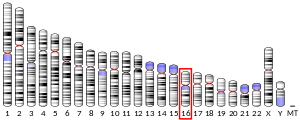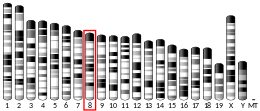Alanyl—tRNA synthetase 1 (AARS1) is an enzyme that is encoded by the AARS1 gene in humans and is a member of the aminoacyl-tRNA synthetases (ARSs) family of enzymes.[5]
Clinical significance
editCharcot-Marie-Tooth Disease
editCharcot-Marie-Tooth Disease type 2 (CMT2) and other peripheral neuropathies have been linked to mutations in the AARS1, GARS1, HARS1, WARS1, and YARS1 genes.[6] Mutations in these genes can encode for faulty aminoacyl-tRNA synthetases, which affects a highly conserved amino acid in the helical domain of cytoplasmic AARS1.[7] This disrupts the ability to charge tRNA with its corresponding amino acids, which leads to impaired protein synthesis. In AARS1, mutations are associated with both autosomal dominant and recessive forms of CMT2.[8]
Trichothiodystrophy
editIn addition to its role in CMT2, mutations in the AARS1 gene have also been implicated in non-photosensitive trichothiodystrophy (NPS-TTD),[9] a rare hereditary neurodevelopmental disorder. Trichothiodystrophy (TTD) is defined by sulfur-deficient brittle hair, nails, and scaly skin,[9] but presents with variable clinical features. Unlike the photosensitive form of TTD (PS-TTD), which exhibits features of progressive neuropathy and accelerated aging, NPS-TTD is not associated with premature aging.[9]
Research has identified AARS1, along with methionyl-tRNA synthetase 1 as genes in which variants can contribute to the development NPS-TTD.[9] These variants lead to the instability of the respective enzymes which they encode, affecting the rate of tRNA charging,[9] which is the first step in protein translation.
References
edit- ^ a b c GRCh38: Ensembl release 89: ENSG00000090861 – Ensembl, May 2017
- ^ a b c GRCm38: Ensembl release 89: ENSMUSG00000031960 – Ensembl, May 2017
- ^ "Human PubMed Reference:". National Center for Biotechnology Information, U.S. National Library of Medicine.
- ^ "Mouse PubMed Reference:". National Center for Biotechnology Information, U.S. National Library of Medicine.
- ^ "AARS1 alanyl-tRNA synthetase 1 [Homo sapiens (human)] - Gene - NCBI". www.ncbi.nlm.nih.gov. Retrieved 2024-11-25.
- ^ Høyer H, Busk ØL, Esbensen QY, Røsby O, Hilmarsen HT, Russell MB, et al. (August 2022). "Clinical characteristics and proteome modifications in two Charcot-Marie-Tooth families with the AARS1 Arg326Trp mutation". BMC Neurology. 22 (1): 299. doi:10.1186/s12883-022-02828-6. PMC 9377087. PMID 35971119.
- ^ Latour P, Thauvin-Robinet C, Baudelet-Méry C, Soichot P, Cusin V, Faivre L, et al. (January 2010). "A major determinant for binding and aminoacylation of tRNA(Ala) in cytoplasmic Alanyl-tRNA synthetase is mutated in dominant axonal Charcot-Marie-Tooth disease". American Journal of Human Genetics. 86 (1): 77–82. doi:10.1016/j.ajhg.2009.12.005. PMC 2801750. PMID 20045102.
- ^ Nam DE, Park JH, Park CE, Jung NY, Nam SH, Kwon HM, et al. (March 2022). "Variants of aminoacyl-tRNA synthetase genes in Charcot-Marie-Tooth disease: A Korean cohort study". Journal of the Peripheral Nervous System. 27 (1): 38–49. doi:10.1111/jns.12476. PMID 34813128.
- ^ a b c d e Botta E, Theil AF, Raams A, Caligiuri G, Giachetti S, Bione S, et al. (August 2021). "Protein instability associated with AARS1 and MARS1 mutations causes trichothiodystrophy". Human Molecular Genetics. 30 (18): 1711–1720. doi:10.1093/hmg/ddab123. PMC 8411986. PMID 33909043.




